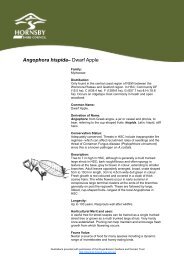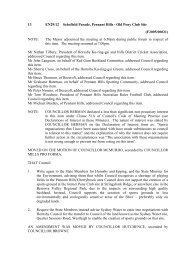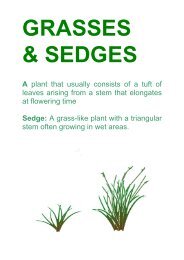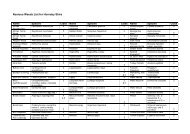Noxious Weeds in Hornsby Shire - Hornsby Shire Council
Noxious Weeds in Hornsby Shire - Hornsby Shire Council
Noxious Weeds in Hornsby Shire - Hornsby Shire Council
You also want an ePaper? Increase the reach of your titles
YUMPU automatically turns print PDFs into web optimized ePapers that Google loves.
LISTED NOXIOUS WEEDS FOR<br />
HORNSBY SHIRE COUNCIL<br />
AS AT MARCH 2012<br />
COMMON NAME BOTANICAL NAME CLASS<br />
African feathergrass Pennisetum macrourum 5<br />
African turnipweed Sisymbrium thellungii<br />
and Sisymbrium runc<strong>in</strong>atum 5<br />
Alligator weed Alternanthera philoxeroides 3<br />
Anchored water hyac<strong>in</strong>th Eichhornia azurea 1<br />
Annual ragweed Ambrosia artemisiifolia 5<br />
Arrowhead Sagittaria montevidensis 4<br />
Artichoke thistle Cynara cardunculus 5<br />
Asparagus fern Asparagus aethiopicus 4<br />
Athel p<strong>in</strong>e Tamarix aphylla 5<br />
Balloon v<strong>in</strong>e Cardiospermum grandiflorum 4<br />
Bear-sk<strong>in</strong> fescue Festuca gautieri 5<br />
Bitou bush Chrysanthemoides monilifera 3<br />
subspecies rotundata<br />
Black knapweed Centaurea nigra 1<br />
Blackberry (exc cultivars Rubus fruticosus aggregate 4<br />
black sat<strong>in</strong> Chehalem species<br />
Chester Thornless Dirksen<br />
Thornless Loch Ness<br />
Murr<strong>in</strong>d<strong>in</strong>di Silvan Smooth<br />
stem Thornfree)<br />
Boneseed Chrysanthemoides monilifera 2<br />
subspecies monilifera<br />
Bridal creeper Asparagus asparagoides 4<br />
Broomrapes (<strong>in</strong>cl all Orobanche species 1<br />
Orobanche species<br />
except native O.cernua<br />
variety australiana<br />
and O.m<strong>in</strong>or)<br />
Burr ragweed Ambrosia confertiflora 5<br />
Cabomba (<strong>in</strong>c all Cabomba species 5<br />
Cabomba species<br />
exc C.furcata)<br />
Camphor laurel C<strong>in</strong>namomum camphora 4<br />
Cape broom Genista monspessulana 3<br />
Cape ivy Delairea odorata 4<br />
Castor oil plant Ric<strong>in</strong>us communis 4<br />
Cat’s claw creeper Macfadyena unguis-cati 4<br />
Cayenne snakeweed Stachytarpheta cayennensis 5<br />
Chilean needle grass Nassella neesiana 4<br />
Ch<strong>in</strong>ese violet Asystasia gangetica 1<br />
subspecies micrantha<br />
Climb<strong>in</strong>g asparagus fern Asparagus plumosus 4<br />
Clockweed Gaura parviflora 5<br />
Corn sowthistle Sonchus arvensis 5<br />
Dodder (<strong>in</strong>c all Cuscuta Cuscuta species 5<br />
species exc native species<br />
C.australis, C.tasmanica<br />
and C.victoriana)<br />
East Indian hygrophila Hygrophila polysperma 4<br />
Elephant grass Arundo donax 4<br />
English broom Cytisus scoparius 4<br />
Espartillo Amelichloa brachychaeta 5<br />
Amelichloa caudata<br />
Eurasian water milfoil Myriophyllum spicatum 1<br />
F<strong>in</strong>e-bristled burr grass Cenchrus brownii 5<br />
Founta<strong>in</strong> grass Pennisetum setaceum 5<br />
Gallon's curse Cenchrus biflorus 5<br />
Giant reed Arundo donax 4<br />
Glaucous starthistle Carthamus glaucus 5<br />
Golden thistle Scolymus hispanicus 5<br />
Gorse Ulex europaeus 3<br />
Green cestrum Cestrum parqui 3<br />
Harrisia cactus Harrisia species 4<br />
Hawkweed Hieracium species 1<br />
Heteranthera Heteranthera reniformis 1<br />
Horsetail Equisetum species 1<br />
Hydrocotyl Hydrocotyl ranunculoides 1<br />
Hygro Hygrophila polysperma 4<br />
Hygrophila Hygrophila costata 2<br />
Hymenachne Hymenachne amplexicaulis 1<br />
and hybrids<br />
Karoo thorn Acacia karoo 1<br />
Kochia (exc B.scoparia Bassia scoparia 1<br />
subspecies tricophylla)<br />
Kosters curse Clidemia hirta 1<br />
Lagarosiphon Lagarosiphon major 1<br />
Lantana Lantana species 4<br />
Leafy elodea Egeria densa 4<br />
Lippia Phyla canescens 4<br />
Long-leaf willow primrose Ludwigia longifolia 3<br />
Ludwigia Ludwigia peruviana 3<br />
Madeira v<strong>in</strong>e Anredera cordifolia 4<br />
Mexican feather grass Nassella tenuissima 1<br />
Mexican poppy Argemone mexicana 5<br />
Miconia Miconia species 1<br />
Mikania Mikania micrantha 1<br />
Mimosa Mimosa pigra 1<br />
Morn<strong>in</strong>g glory (coastal) Ipomoea cairica 4<br />
Morn<strong>in</strong>g glory (purple) Ipomoea <strong>in</strong>dica 4<br />
Mossman River grass Cenchrus ech<strong>in</strong>atus 5<br />
Ochna Ochna serrulata 4<br />
Pampas grass Cortaderia species 3<br />
Parthenium weed Parthenium hysterophorus 1<br />
Pellitory Parietaria judaica 4<br />
Pond apple Annona glabra 1<br />
Prickly acacia Acacia nilotica 1<br />
Prickly pear Cyl<strong>in</strong>dropuntia species 4<br />
Prickly pear (<strong>in</strong>c all Opuntia species 4<br />
Opuntia species exc<br />
O.ficus-<strong>in</strong>dica)<br />
Privet (Broad-leaf) Ligustrum lucidum 4<br />
Privet (narrow-leaf Ligustrum s<strong>in</strong>ense 4<br />
/Ch<strong>in</strong>ese)<br />
Red rice Oryza rufipogon 5<br />
Rhizomatous bamboo Pyllostachys species 4<br />
Rhus tree Toxicodendron succedaneum 4<br />
Rubberv<strong>in</strong>e Cryptostegia grandiflora 1<br />
Sagittaria Sagittaria platyphylla 5<br />
Salv<strong>in</strong>ia Salv<strong>in</strong>ia molesta 2<br />
Scotch broom Cytisus scoparius 4<br />
Senegal tea plant Gymnocoronis spilanthoides 1<br />
Serrated tussock Nassella trichotoma 4<br />
Siam weed Chromolaena odorata 1<br />
Smooth-stemmed turnip Brassica barrelieri 5<br />
subspecies oxyrrh<strong>in</strong>a<br />
Soldier thistle Picnomon acarna 5<br />
Spotted knapweed Centaurea stoebe subspecies 1<br />
micranthos<br />
St John’s wort Hypericum perforatum 4<br />
Texas blueweed Helianthus ciliaris 5<br />
Trad Tradescantia flum<strong>in</strong>ensis 4<br />
Tropical soda apple Solanum viarum 2<br />
Turkey rhubarb Acetosa sagittata 4<br />
Tussock paspalum Paspalum quadrifarium 3<br />
Wander<strong>in</strong>g Jew Tradescantia flum<strong>in</strong>ensis 4<br />
Water caltrop Trapa species 1<br />
Water hyac<strong>in</strong>th Eichhornia crassipes 2<br />
Water lettuce Pistia stratiotes 1<br />
Water soldier Stratiotes aloides 1<br />
Willow (<strong>in</strong>c all Salix Salix species 5<br />
species exc S.babylonica,<br />
S. x reichardtii,<br />
S. x calodendron)<br />
Witchweed (Striga Striga species 1<br />
species exc the native<br />
Striga parviflora)<br />
Yellow burrhead Limnocharis flava 1<br />
Yellow nutgrass Cyperus esculentus 5
Class 1 - State Prohibited <strong>Weeds</strong>. The plant must be<br />
eradicated from the land and the land must be kept free of<br />
the plant. The weeds are also "notifiable" and a range of<br />
restrictions on their sale and movement exist.<br />
Class 2 - Regionally Prohibited <strong>Weeds</strong>. The plant must be<br />
eradicated from the land and the land must be kept free of<br />
the plant. The weeds are also "notifiable" and a range of<br />
restrictions on their sale and movement exist.<br />
Class 3 - Regionally Controlled <strong>Weeds</strong>. The plant must be<br />
fully and cont<strong>in</strong>uously suppressed and destroyed.<br />
Class 4 - Locally Controlled <strong>Weeds</strong>. The growth of the plant<br />
must be managed <strong>in</strong> a manner that reduces its numbers<br />
spread and <strong>in</strong>cidence and cont<strong>in</strong>uously <strong>in</strong>hibits its<br />
reproduction.<br />
Class 5 - Restricted Plants. There are no requirements to<br />
control exist<strong>in</strong>g plants of Class 5 weeds. However, the weeds<br />
are "notifiable" and a range of restrictions on their sale and<br />
movement exists.<br />
WEED CONTROL TECHNIQUES<br />
CUT AND PAINT<br />
To ensure a thorough kill, the herbicide must be applied<br />
with<strong>in</strong> 20 seconds of the cut be<strong>in</strong>g made. Ensure you wear<br />
thick PVC coated gloves when do<strong>in</strong>g this.<br />
SCRAPE AND PAINT<br />
To ensure a thorough kill, the herbicide must be applied<br />
with<strong>in</strong> 20 seconds of the cut be<strong>in</strong>g made. Ensure you wear<br />
thick PVC coated gloves when do<strong>in</strong>g this.<br />
CROWN REMOVAL FOR ASPARAGUS<br />
SPECIES<br />
The grow<strong>in</strong>g po<strong>in</strong>ts of the Asparagus Fern must be removed<br />
below the surface. The numerous water filled tubers can be left <strong>in</strong><br />
the ground as the plant cannot regrow from them. Ensure you<br />
wear thick gloves when do<strong>in</strong>g this.<br />
FRILLING<br />
To ensure a thorough kill, the herbicide must be applied with<strong>in</strong> 20<br />
seconds of the cut be<strong>in</strong>g made. An axe can be used with this<br />
method. Ensure you wear thick PVC coated gloves when do<strong>in</strong>g<br />
this.<br />
DRILL AND INJECT<br />
To ensure a thorough kill, the herbicide must be applied with<strong>in</strong> 20<br />
seconds of the hole be<strong>in</strong>g drilled. Holes should drilled at 100mm<br />
<strong>in</strong>tervals around the trunk at a downward 45° angle. Holes should<br />
be about 6mm wide and 25mm deep. If plant is multi stemmed,<br />
treat each stem as a separate trunk. Ensure you wear thick PVC<br />
coated gloves when do<strong>in</strong>g this.<br />
NOXIOUS WEEDS LIST<br />
AND<br />
CONTROL TECHNIQUES<br />
For advice on relevant chemicals, please contact<br />
<strong>Council</strong> on (02) 9847 6832<br />
NOTE: The label on any chemical is a Legal Document.<br />
Please read the label before commenc<strong>in</strong>g any control<br />
work <strong>in</strong>volv<strong>in</strong>g chemicals.<br />
Control technique diagrams courtesy of the National Trust










